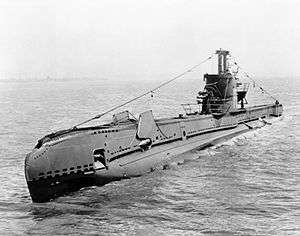HMS Stonehenge (P232)
 HMS Stonehenge | |
| History | |
|---|---|
| Name: | HMS Stonehenge |
| Builder: | Cammell Laird, Birkenhead |
| Laid down: | 4 April 1942 |
| Launched: | 23 March 1943 |
| Commissioned: | 15 June 1943 |
| Fate: | Presumed sunk on or about 15 March 1944 |
| Badge: |
 |
| General characteristics | |
| Class and type: | S-class submarine |
| Displacement: |
|
| Length: | 217 ft (66.1 m) |
| Beam: | 23 ft 9 in (7.2 m) |
| Draught: | 14 ft 8 in (4.5 m) |
| Installed power: |
|
| Propulsion: |
|
| Speed: |
|
| Range: | 6,000 nmi (11,000 km; 6,900 mi) at 10 knots (19 km/h; 12 mph) surface; 120 nmi (220 km; 140 mi) at 3 knots (5.6 km/h; 3.5 mph) submerged |
| Test depth: | 300 feet (91.4 m) |
| Complement: | 48 |
| Armament: |
|
HMS Stonehenge was a S-class submarine of the third batch built for the Royal Navy during World War II. She was lost and presumed sunk in 1944.
Design and description
The third batch was slightly enlarged and improved over the preceding second batch of the S-class. The submarines had a length of 217 feet (66.1 m) overall, a beam of 23 feet 9 inches (7.2 m) and a draft of 14 feet 8 inches (4.5 m). They displaced 842 long tons (856 t) on the surface and 990 long tons (1,010 t) submerged.[1] The S-class submarines had a crew of 48 officers and ratings. They had a diving depth of 300 feet (91.4 m).[2]
For surface running, the boats were powered by two 950-brake-horsepower (708 kW) diesel engines, each driving one propeller shaft. When submerged each propeller was driven by a 650-horsepower (485 kW) electric motor. They could reach 15 knots (28 km/h; 17 mph) on the surface and 10 knots (19 km/h; 12 mph) underwater.[3] On the surface, the third batch boats had a range of 6,000 nautical miles (11,000 km; 6,900 mi) at 10 knots (19 km/h; 12 mph) and 120 nmi (220 km; 140 mi) at 3 knots (5.6 km/h; 3.5 mph) submerged.[2]
The boats were armed with seven 21-inch torpedo tubes. A half-dozen of these were in the bow and there was one external tube in the stern. They carried six reload torpedoes for the bow tubes for a grand total of thirteen torpedoes. Twelve mines could be carried in lieu of the internally stowed torpedoes. They were also armed with a 3-inch (76 mm) deck gun.[4]
Construction and career
HMS Stonehenge was built by Cammell Laird and launched on 23 March 1943. She served in the Pacific, where she sank the Japanese merchant vessel Koryo Maru No.2 and the Japanese auxiliary minelayer Choko Maru. She left Trincomalee to patrol in the northern part of the Malacca Straits on 25 February 1944.[5] She was reported missing after failing to arrive at Ceylon on 20 March as expected. It is not known for sure what caused her sinking, but a mine was considered to be the most likely explanation.[6]
Notes
- ↑ Chesneau, p. 51
- 1 2 McCartney, p. 7
- ↑ Bagnasco, p. 110
- ↑ Chesneau, pp. 51–52
- ↑ HMS Stonehenge, Uboat.net
- ↑ Submarine losses 1904 to present day, RN Submarine Museum, Gosport
References
- Akermann, Paul (2002). Encyclopaedia of British Submarines 1901–1955 (reprint of the 1989 ed.). Penzance, Cornwall: Periscope Publishing. ISBN 1-904381-05-7.
- Bagnasco, Erminio (1977). Submarines of World War Two. Annapolis, Maryland: Naval Institute Press. ISBN 0-87021-962-6.
- Chesneau, Roger, ed. (1980). Conway's All the World's Fighting Ships 1922–1946. Greenwich, UK: Conway Maritime Press. ISBN 0-85177-146-7.
- Colledge, J. J.; Warlow, Ben (2006) [1969]. Ships of the Royal Navy: The Complete Record of all Fighting Ships of the Royal Navy (Rev. ed.). London: Chatham Publishing. ISBN 978-1-86176-281-8. OCLC 67375475.
- McCartney, Innes (2006). British Submarines 1939–1945. New Vanguard. 129. Oxford, UK: Osprey. ISBN 1-84603-007-2.
Coordinates: 5°46′N 99°52′E / 5.767°N 99.867°E